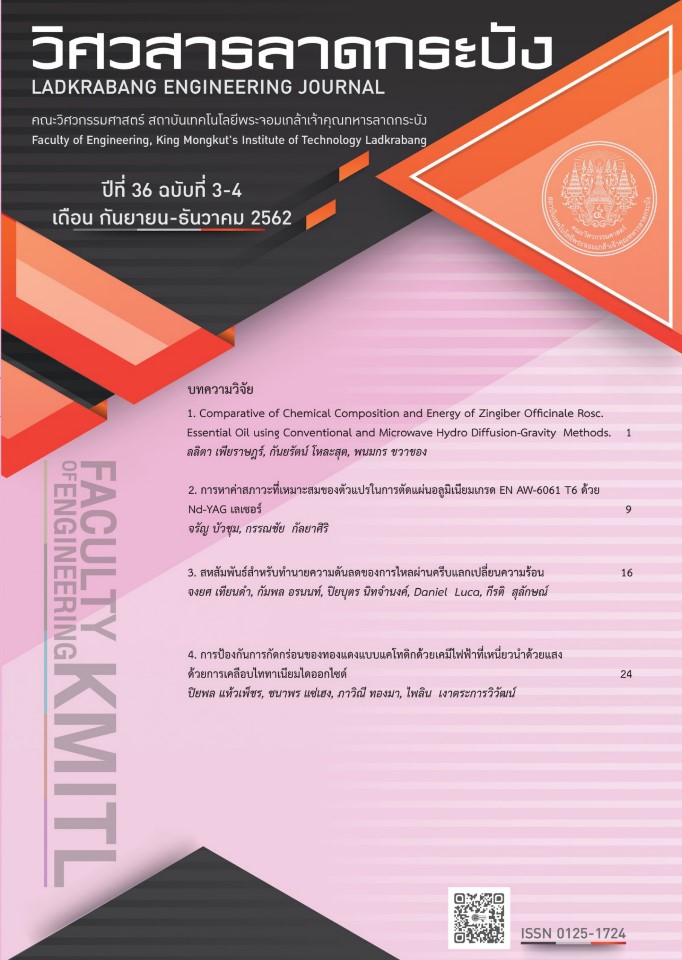Optimization of Nd-YAG Laser Cutting Variables for EN AW-6061 T6 Aluminium Plate
Keywords:
Laser cutting, Aluminium alloys, Design of experiments, Automotive and aerospace partsAbstract
The objective of this research was to optimize Nd-YAG laser cutting condition for EN AW-6061 aluminum to minimize surface roughness. A 2k factorial design was employed to study on the effects of cutting variables, including laser power, cutting speed, frequency and nozzle distance. Results showed that all of these cutting variables significantly affect surface roughness of the specimen and the optimal cutting condition was laser power of 3000 W, cutting speed of 1.4 mm/min, frequency of 2000 Hz and nozzle distance of 0.5 mm. The confirmation test was conducted and provided the surface roughness of 1.86 m which passed the customer requirement.
References
J. Priyanka, S. Amit, “Simultaneous optimization of kerf taper and heat affected zone in ND-YAG laser of Al 6061-T6 sheet using hybrid approach of grey relational analysis and fuzzy logic,” Journal of Precision Engineering, vol. 54, pp. 302-312, 2018.
M. Milos, A. Jurgita, R. Miroslav, P. Dusan. “Determination of laser cutting process conditions using the preference selection index method,” Optic & Laser Technology, vol. 89, pp. 214-220, 2017.
R. Adalarasan, M. Santhanakumar, M. Rajmohan, “Optimization of laser cutting parameters for Al6061/SiCp/Al2O3 composite using grey based response surface methodology (GRSM),” Journal of Measurement, vol. 73, pp. 569-606, 2015.
F. Quintero, J. Pou, F. Lusquinos,M. Boutinguiza, R. Soto,M. Perez-Amor, “Quantitative evaluation of the quality of the cuts performed on mullite-alumina by Nd: YAG laser,” Optics and Laser in Engineering, vol. 42, pp. 327-340, 2004.
N. Rajaram, J. Sheikh-Ahmad, S. H. Cheraghi, “CO2 laser cut quality of 4130 steel,” International Journal of Machine Tool and Manufacture, vol. 43, pp. 351-358, 2003.
K. Abdel Ghany, M. Newishy , “Cutting of 1.2 mm thick austenitic stainless steel sheet using pulsed and CW Nd: YAG laser,” Journal of Material Processing Technology, vol. 168, pp. 438-447 2005.
K. Sefika, S. I. Etem, “Determination of process parameters in the laser micromilling application using Taguchi method a case study for AISI H13 tool steel,” International Journal Advanced Manufacturing Technology, vol. 58, pp. 201-209, 2012.
K. D. Avanish, Y. Vinod, “Multi-objective optimisation of laser beam cutting process,” Optic & Laser Technology, vol. 40, pp. 562–570, 2008.
N. Rajaram, J. Sheikh-Ahmad, S. H. Cheraghi, “CO2 laser cut quality of 4130 steel,” International Journal of Machine Tools & Manufacture, Vol 43, pp. 351-358, 2003.
R.Neimeyer, R.N. Smith, D.A.Kaminski, “Effects of operating parameters on surface quality laser cutting of mild steel,” Journal of Engineering for Industry, Vol. 115, pp. 359-366, 1993.
Douglas C. Montgomery, “Design and Analysis of Experiments,” Eighth Edition, New York, John Wiley and Sons, 2013.
K.K. Mandal , A.S. Kuar, S. Mitar, “Experimental investigation on laser micro-machining of Al 7075 alloy,” Optics and Laser Technology, Vol. 107, pp. 260-267, 2018.
P. Jankovic, M. Modic, M. Radovanovic, D. Petkovic, S. Mladenovic, “Optimization of Surface Roughness from Different Aspects in High-Power CO2 Laser Cutting of AA5754 Aluminum Alloy,” Arabian Journal for Science and Engineering, Vol. 44, pp. 10245-10256, 2019.
Downloads
Published
How to Cite
Issue
Section
License
The published articles are copyrighted by the School of Engineering, King Mongkut's Institute of Technology Ladkrabang.
The statements contained in each article in this academic journal are the personal opinions of each author and are not related to King Mongkut's Institute of Technology Ladkrabang and other faculty members in the institute.
Responsibility for all elements of each article belongs to each author; If there are any mistakes, each author is solely responsible for his own articles.






